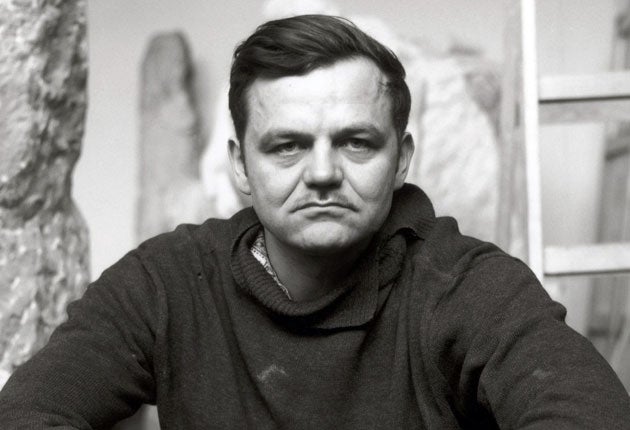Alfred Hrdlicka: Artist who outraged Catholic groups with his homo-erotic depiction of the Last Supper

Your support helps us to tell the story
From reproductive rights to climate change to Big Tech, The Independent is on the ground when the story is developing. Whether it's investigating the financials of Elon Musk's pro-Trump PAC or producing our latest documentary, 'The A Word', which shines a light on the American women fighting for reproductive rights, we know how important it is to parse out the facts from the messaging.
At such a critical moment in US history, we need reporters on the ground. Your donation allows us to keep sending journalists to speak to both sides of the story.
The Independent is trusted by Americans across the entire political spectrum. And unlike many other quality news outlets, we choose not to lock Americans out of our reporting and analysis with paywalls. We believe quality journalism should be available to everyone, paid for by those who can afford it.
Your support makes all the difference.Alfred Hrdlicka was a Viennese artist and sculptor who caused an uproar with his portrayal of the Last Supper, in which he depicted Jesus being fondled and the Apostles groping one other. In April 2008 an exhibition of his work, Religion, Flesh and Power, caused outrage when it was displayed in a museum attached to Vienna's Roman Catholic St Stephen's Cathedral. Following protestations from Catholic groups that some of the pictures were blasphemous, Cardinal Christoph Schönborn ordered the removal of the most controversial picture, Leonardo's Last Supper, in which the Apostles engaged in what the artist described as a "homosexual orgy".
Cardinal Schönborn explained that the removal had nothing to do with censorship and added that it was removed with "reverence for the sacred". Nevertheless, the exhibition did not lose its "controversial" tag, as other pictures which also proved contentious – including one showing Christ being fondled while on the cross – were left on display. Some of the local media likened the controversy to the bitter arguments that surrounded the cartoon portrayal of Islam's prophet Mohammed, which was published in September 2005 in the Danish newspaper Jyllands-Posten, and led to protests and violence around the world.
Bernhard Boehler, the museum's curator, insisted that despite the criticism, the exhibition served its purpose by encouraging debate. He believed Hrdlicka was entitled to represent people in this carnal, drastic way. He added, "People can imagine what they want to." According to notes accompanying the exhibition, Hrdlicka's work focused on the carnality of religion, and on the search for "God as a human experience".
Alfred Hrdlicka was born in 1928 in Vienna. He initially trained as a dental technician, and then, between 1946 and 1952, studied painting at Vienna's Academy of Fine Arts under Josef Dobrowsky and Albert Paris Gütersloh. He then studied sculpture with Fritz Wotruba until 1957. Hrdlicka's first exhibition, Skulptur, Malerei und Graphik, took place in 1960 at the Zedlitzhalle in Vienna and four years later, along with Herbert Boeckl, he represented Austria at the 32nd Biennale in Venice.
Hrdlicka went on to teach at fine-art academies in Stuttgart, Hamburg and Berlin before returning to the Austrian capital and a professorship at the University for Applied Arts in Vienna.
Known to have been deeply influenced by his studies of the mentally ill during the late 1960s, Hrdlicka turned to a figurative expressive style meant to provoke his audience to confront the world's anguish, pain and misery. For him, art was agitprop and he understood his life as an artist as a mission to educate the public to oppose war and violence. An atheist who espoused communist beliefs, Hrdlicka married religious themes with topics considered taboo among believers.
As a result of some of his public sculptures in Austria and Germany, and in reaction to the unveiling of one of his works, a so-called "League against Degenerate Art" was formed in 1967. In 1969 a comprehensive exhibition of his graphic works was shown at the Albertina, Vienna, and in 1985 a retrospective was held at the Akademie der Künste in the former East Berlin.
Among his better-known works was, perhaps, his cast-iron sculpture of a prostrate figure covered by barbed wire that he created from 1988 to 1991 in Albertinaplatz, opposite Vienna's Albertina Museum, in the city centre. It was on the site of the Philipphof, a block of flats that had collapsed killing more than 200 people who had sought shelter from Allied bombing raids in its cellars in 1945. The starkly disturbing Memorial against War and Fascism has been occasionally defaced since it was unveiled in 1991.
His oft-cited dictum, "all art comes from flesh" is reflected in his later works. For Hrdlicka, art that avoided the human condition was nothing more than decoration and entertainment and not to be taken seriously. He consistently rejected awards on the grounds of principle. In addition to his everyday work, Hrdlicka was also highly sought-after across Europe as a set designer on opera and theatre stages.
The Austrian President, Heinz Fischer, said in response to the news of Hrdlicka's death that "Austria has lost a great artistic personality". The Social Democratic Chancellor, Werner Faymann, praised the artist as "a great fighter against injustice and the oppression of human beings." Culture Minister Claudia Schmied called Hrdlicka "a titan of international art" and a confident and controversial person. She believed that his life work was an attempt to improve the world and that "his art will always remind us of that need".
Martin Childs
Alfred Hrdlicka, artist: born Vienna 27 February 1928; died Vienna 5 December 2009.
Join our commenting forum
Join thought-provoking conversations, follow other Independent readers and see their replies
Comments